Mn-doped Ge and Si: A Review of the Experimental Status
Abstract
:1. Background and Introduction
1.1. GaMnAs: Promises and Questions
1.2. Alternatives: Mn-Doped Si and Ge
- Is there any experimental proof that Mn can substitute Si or Ge?
- Are some Mn-rich precipitates formed in Si or Ge upon Mn doping?
- How can Mn-rich precipitates be avoided?
- Are there any magneto-transport experiments supporting carrier-mediated ferromagnetism in Mn-doped Si or Ge?
2. Mn-Doped Ge
2.1. Substitutional Mn in Ge
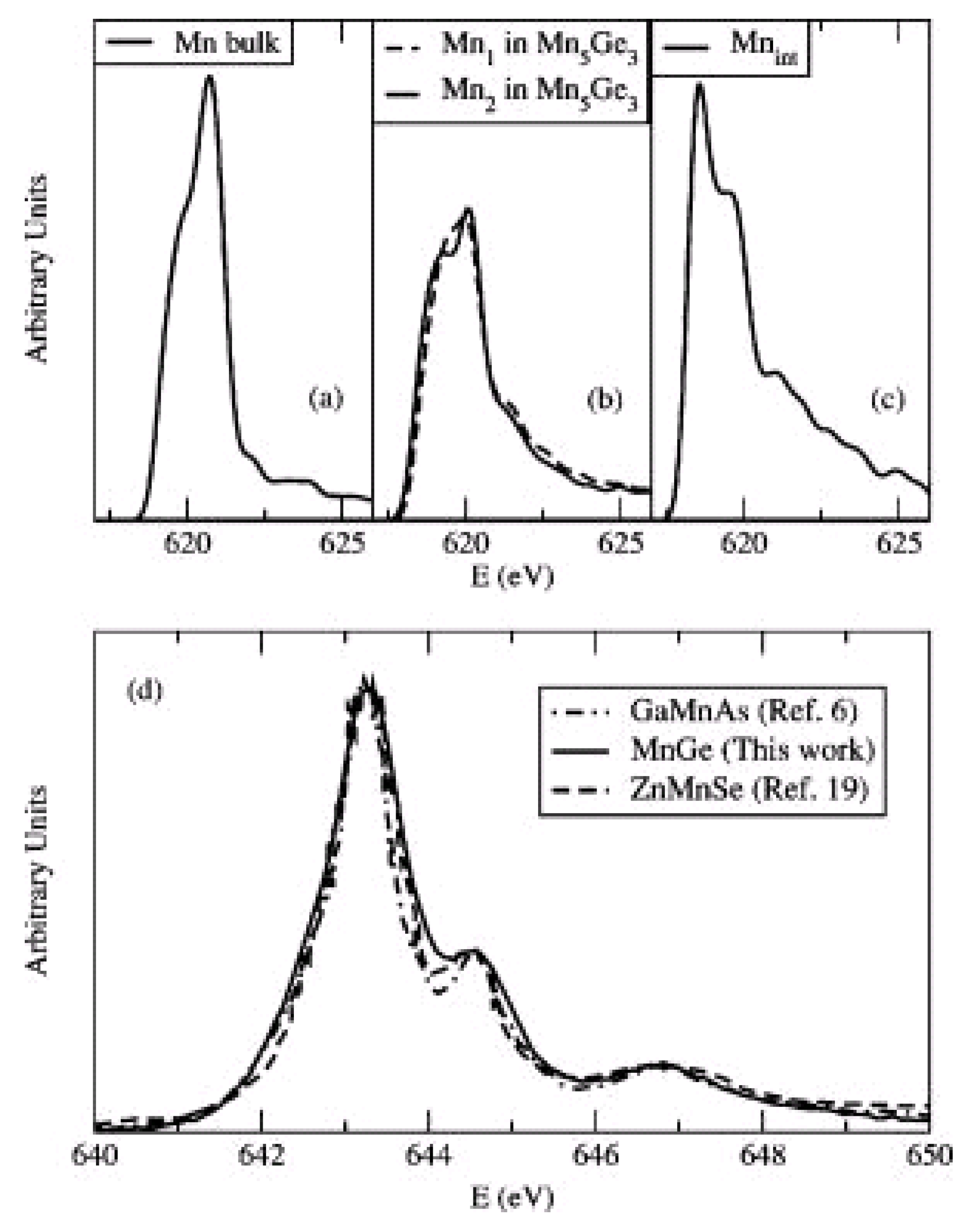
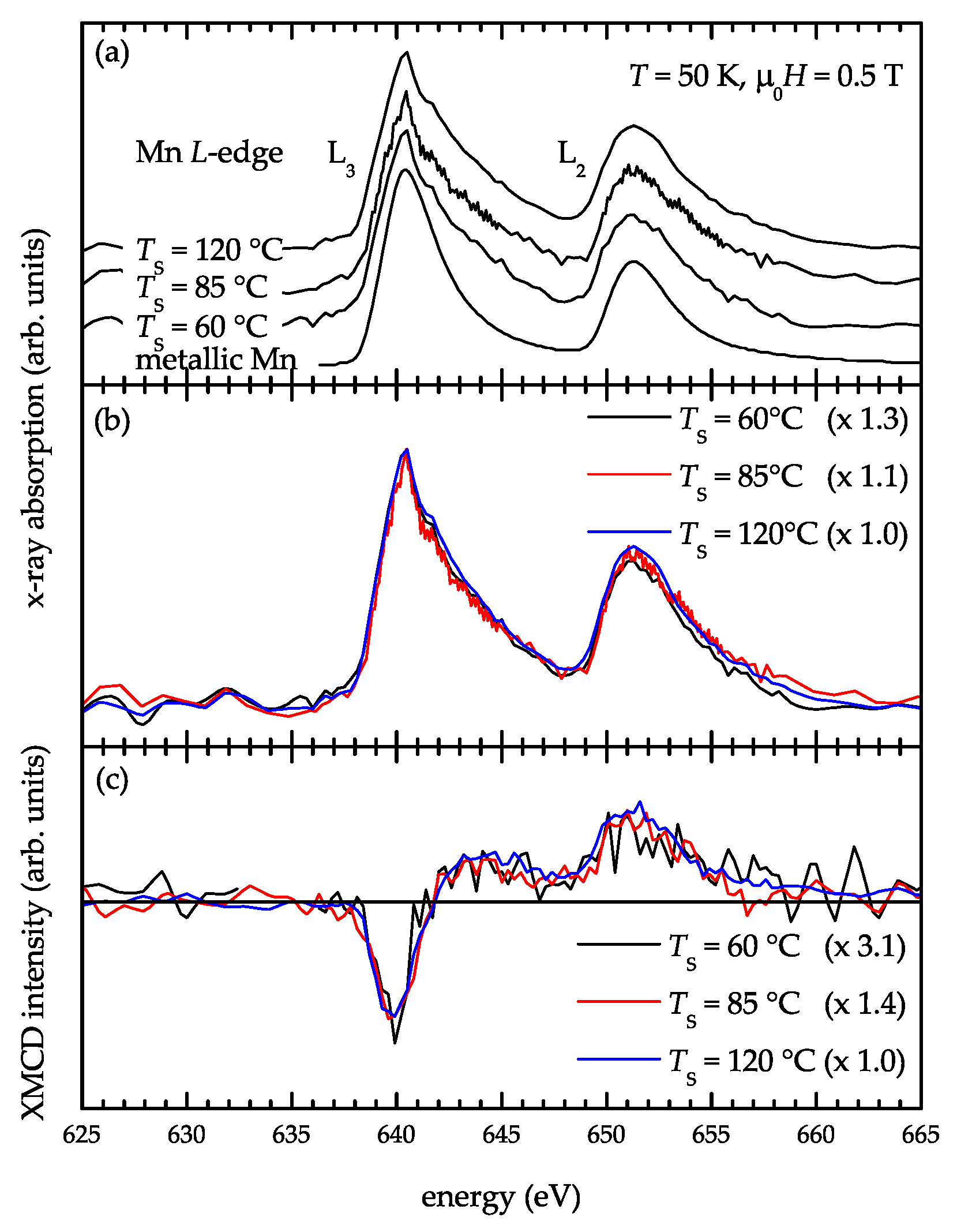
2.2. Phase Separation of Mn in Ge




2.3. Magnetism in Ge:Mn
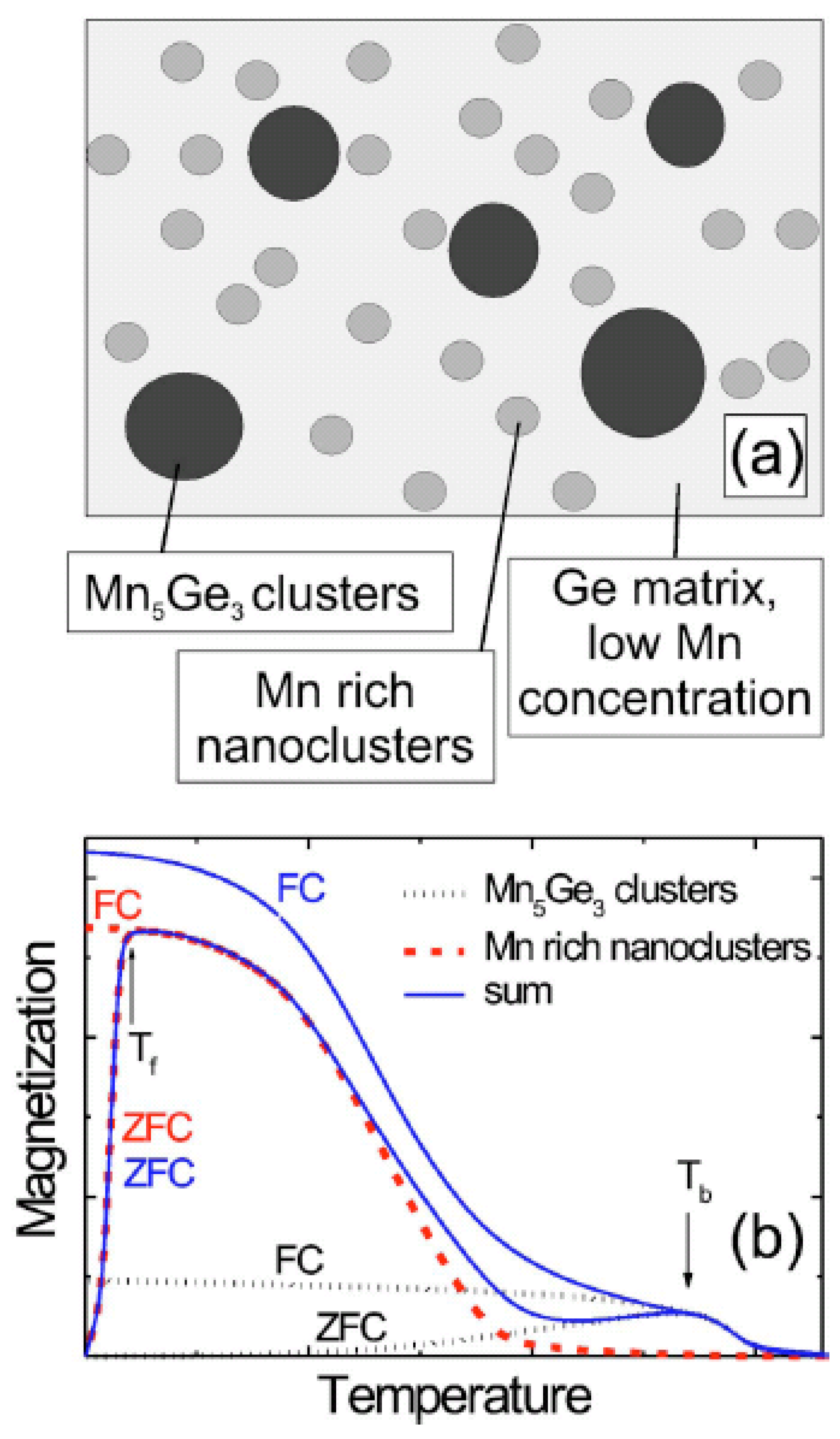
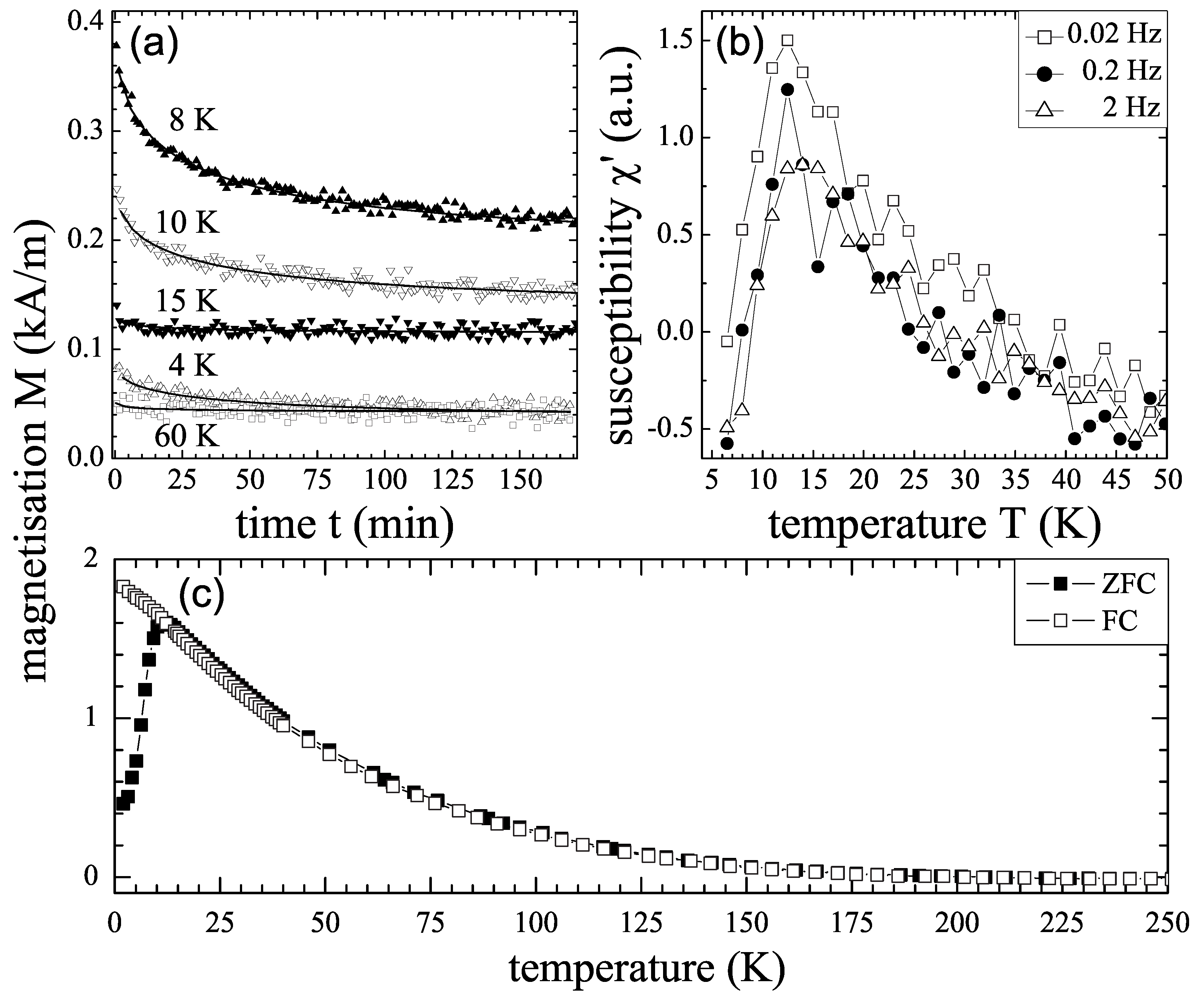


2.4. Magnetotransport
| ID | Mn conc. | Hole conc. | Properties | |
| % | cm−2 | Precipitates | Ferromagnetic | |
| Ge19 | 0.004 | - | No | No |
| Ge01 | 0.2 | 6.5×1012 | No | No |
| Ge02 | 2 | 1.1×1013 | Mn5Ge3 | Yes |
| Ge03 | 10 | 2.0×1013 | Mn5Ge3 | Yes |

2.5. Pulsed Laser Annealing of Mn Implanted Ge
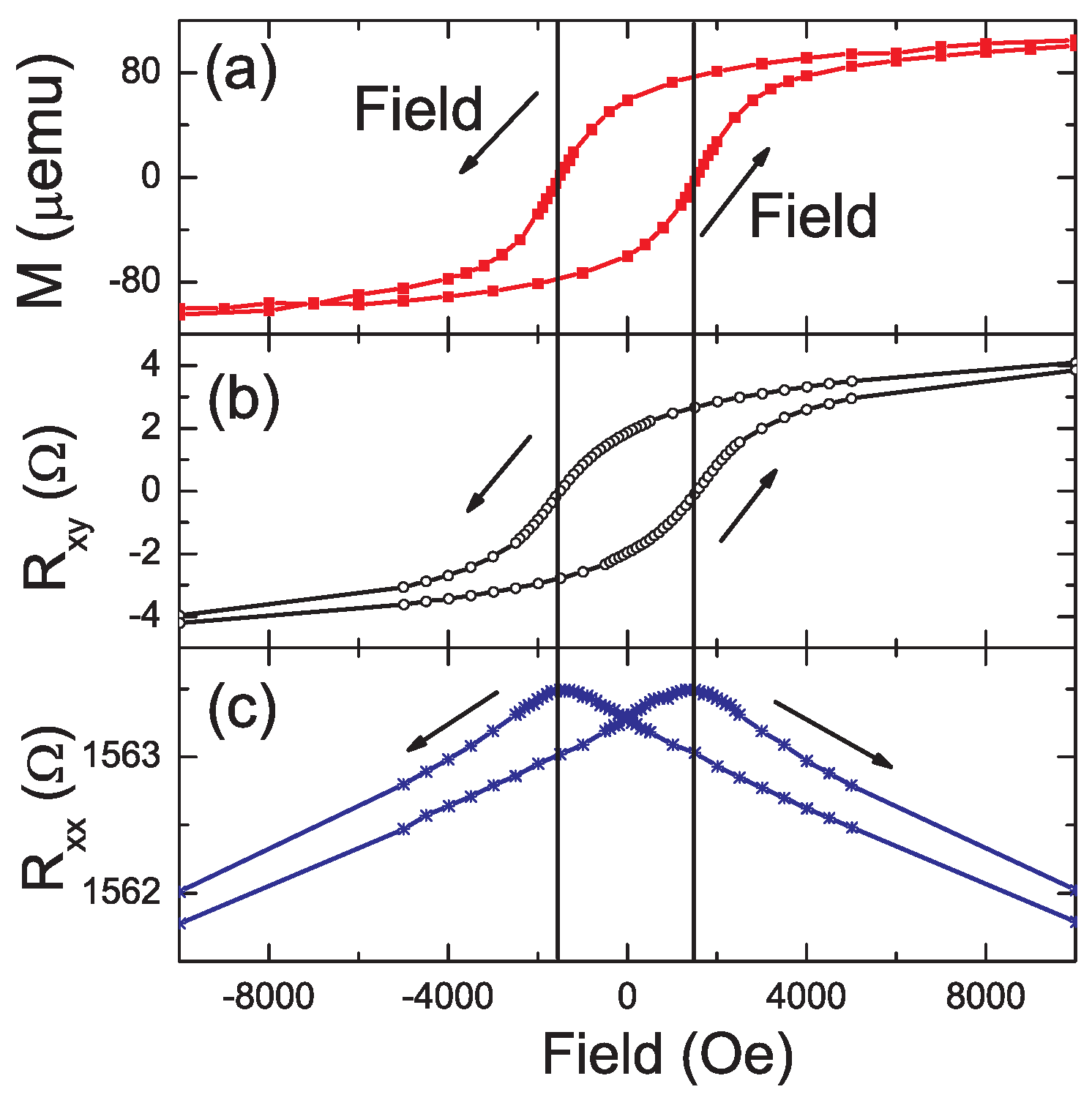
3. Mn-Doped Si
- 3d transition metals diffuse predominantly as interstitials in Si with an activation energy of diffusion near 0.75 eV, and stay in interstitial sites at high temperature in thermal equilibrium;
- V, Cr, Mn, and Fe can be quenched in interstitial sites of tetrahedral symmetry, and Co, Ni, and Cu vanish out of the interstitial solutions during quenching;
- Energy levels for the interstitial species and various pairs have been established, based mainly on combinations of different experimental methods with EPR results;
- Substitutional 3d metals in silicon are rather exotic species, produced under non-equilibrium conditions like irradiation. Their energy levels have not been established.
3.1. Mn in Si: Substitutional?


3.2. Mn-Silicide Formation


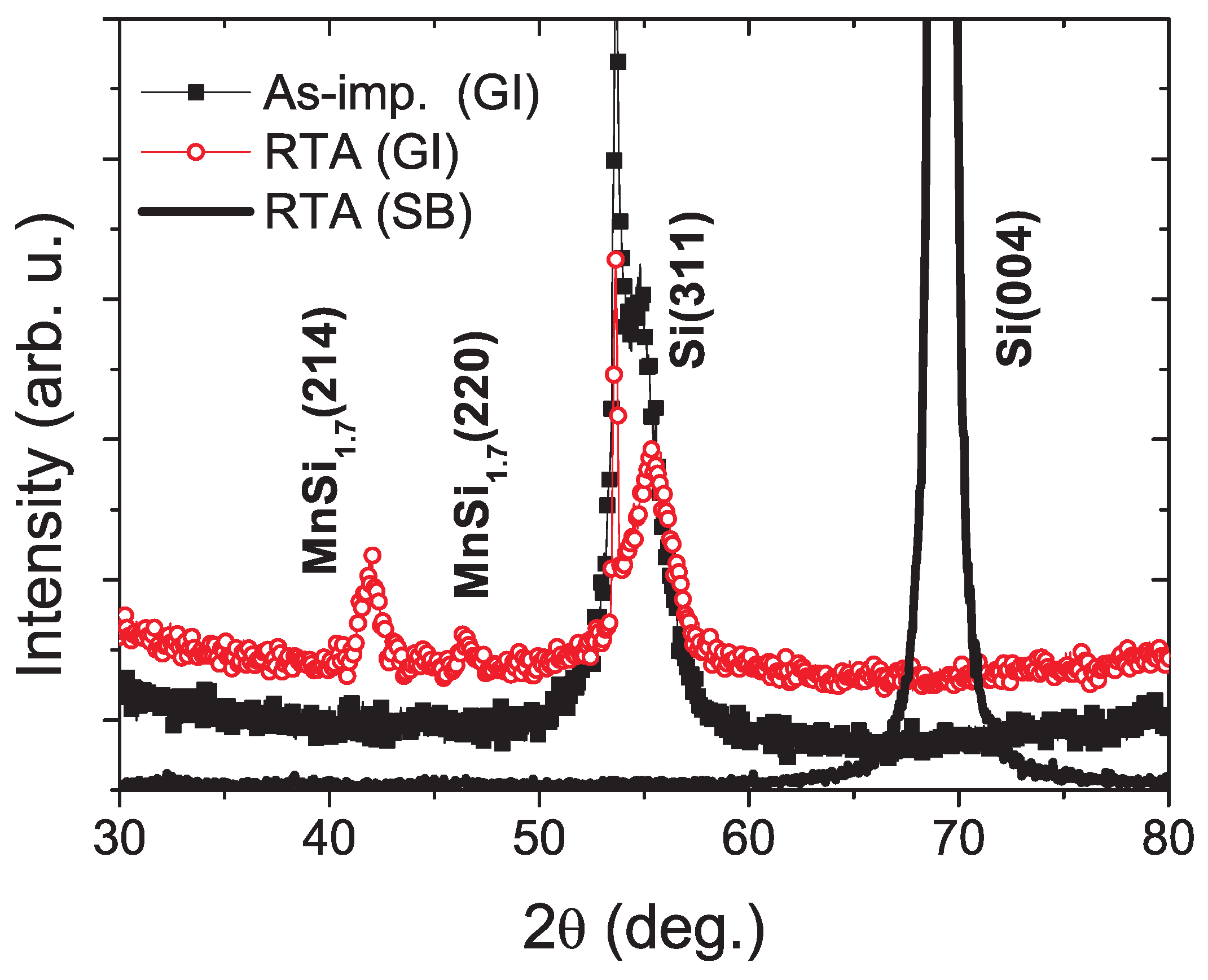
3.3. Magnetic Properties
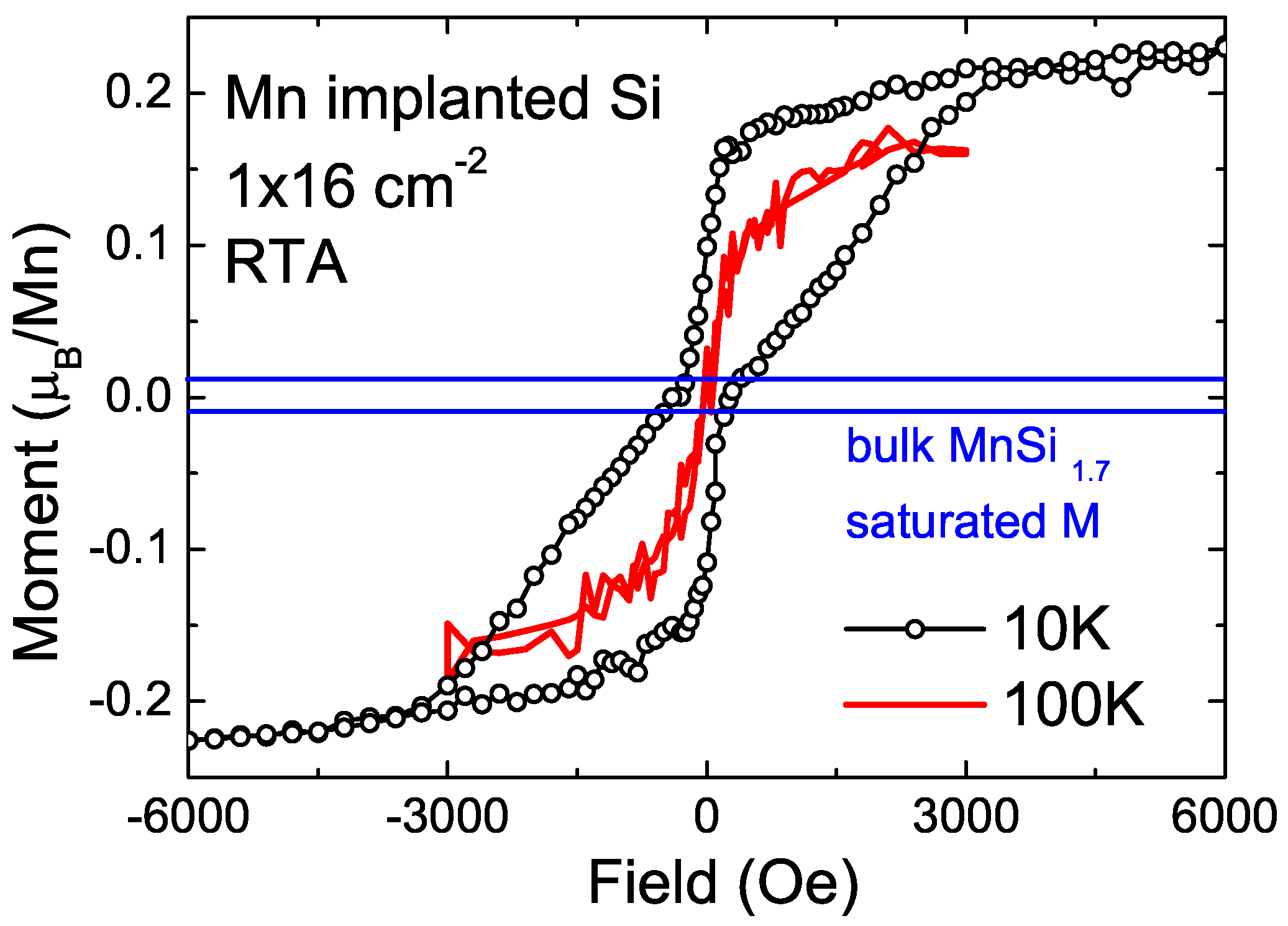
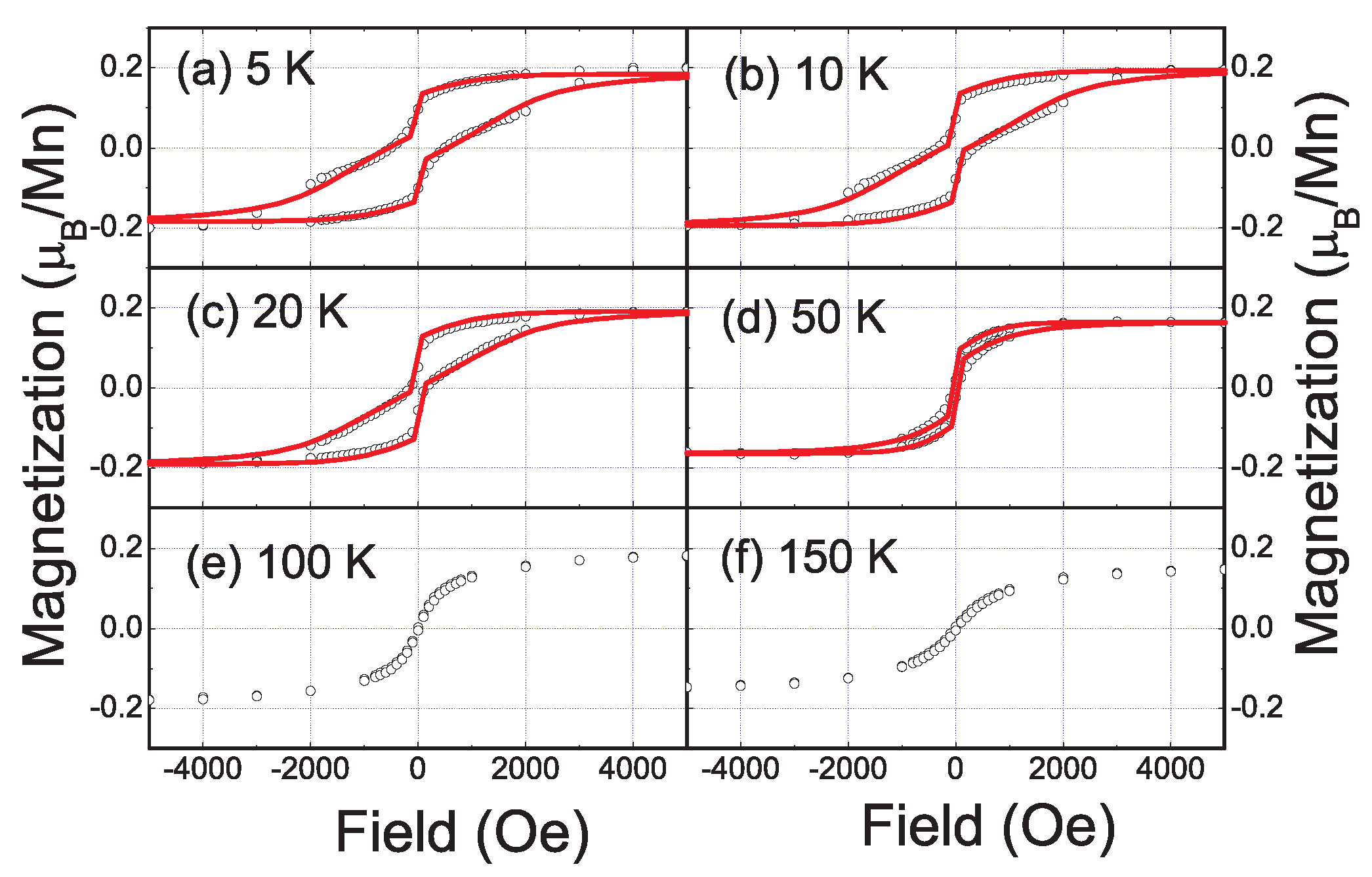
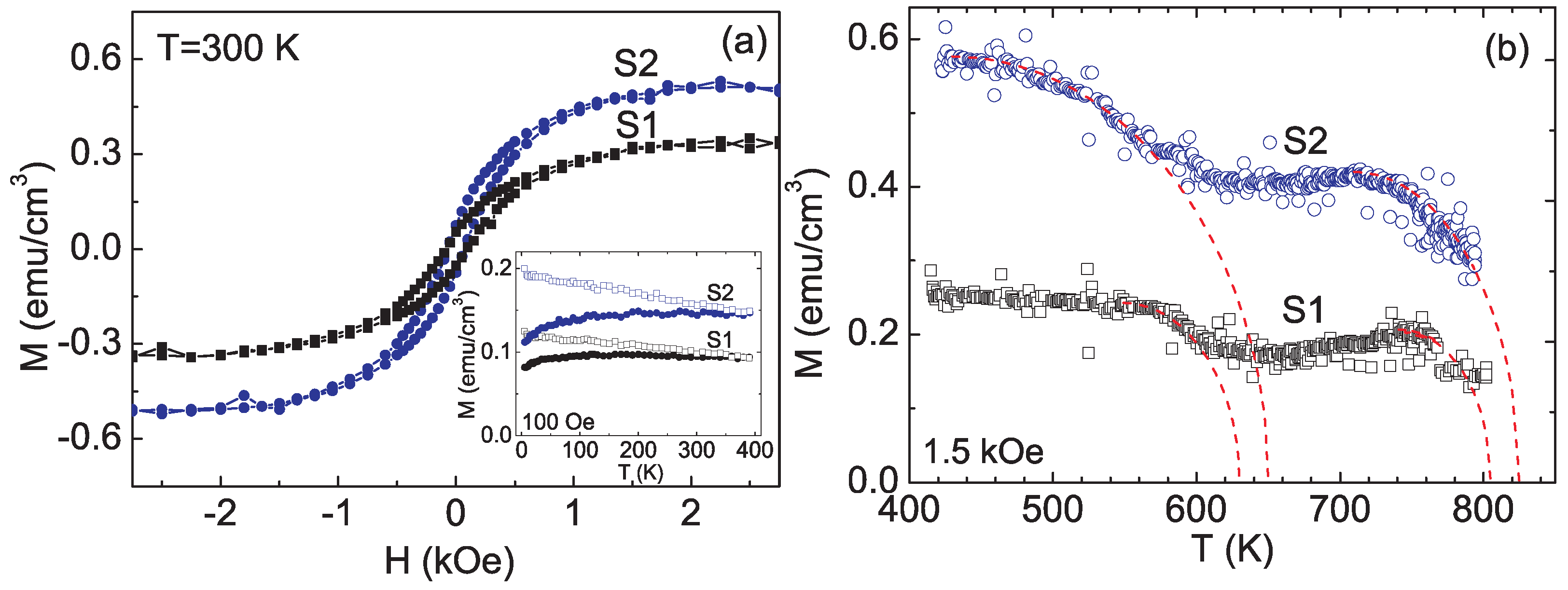
3.4. Magnetotransport Properties
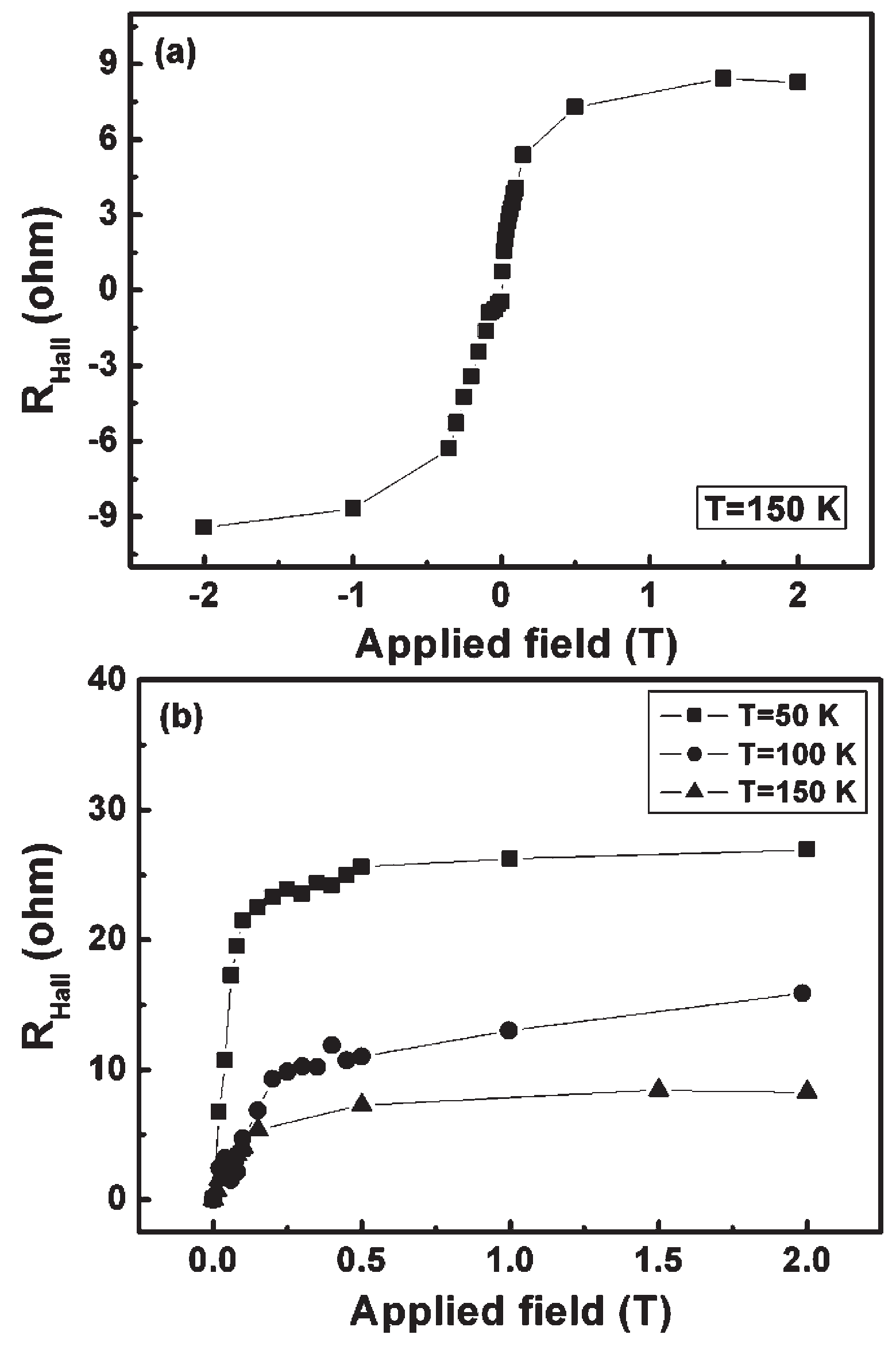
4. Summary and outlook
| II-VI | III-V | Elemental | ||||
| ZnO | ZnTe | GaAs | GaN | Ge | Si | |
| Substitutional Mn | isovalent | isovalent | acceptor | acceptor | double acceptor | - |
| Interstitial Mn | - | - | donor | donor | donor | donor or acceptor |
| Acceptor co-dopants | P, N | N | Be, Mg | Zn | Ga | B, Al, Ga |
- There is a considerable amount of Mn diluted inside the Ge matrix, resulting in p-type doping.
- Mn ions inside the Ge matrix tend to form secondary phases or Mn-rich nanostructures even at preparation temperatures as low as 70 °C.
- The observed ferromagnetism in Mn-doped Ge is usually multi-fold originated. The magnetic phase ordering below around 20 K likely results from the hole-mediated coupling between diluted Mn ions.
- The previously reported magnetotransport properties are much different from those of GaAs:Mn, and cannot be taken as the evidence of carrier-mediated ferromagnetism.
- Besides LT-MBE, an alternative preparation approach is ion implantation followed by pulsed laser annealing offering a high temperature (at the Ge molten point) and short time (as short as nano-second) process. It promises a more effective substitution of Mn inside the Ge matrix.
- It is still unclear if Mn can substitute the Si site.
- The observed ferromagnetism in Mn-doped Si is usually multi-fold originated. One source is nanocrystalline MnSi1.7.
- It is difficult to make comments on the existence of carrier mediated ferromagnetism in Mn-doped Si since there are only limited reports on its magnetotransport properties.
- One possible approach for a Si FMS would be ion implantation of other 3d transition metals followed by pulsed laser annealing. The chosen 3d transition metal ions should quench out of interstitial sites during pulsed laser annealing and form acceptor states in Si.
5. Acknowledgements
References
- Binasch, G.; Grünberg, P.; Saurenbach, F.; Zinn, W. Enhanced magnetoresistance in layered magnetic structures with antiferromagnetic interlayer exchange. Phys. Rev. B 1989, 39, 4828–4830. [Google Scholar] [CrossRef]
- Baibich, M.N.; Broto, J.M.; Fert, A.; van Dau, F.N.; Petroff, F.; Eitenne, P.; Creuzet, G.; Friederich, A.; Chazelas, J. Giant Magnetoresistance of (001)Fe/(001)Cr Magnetic Superlattices. Phys. Rev. Lett. 1988, 61, 2472–2475. [Google Scholar] [CrossRef] [PubMed]
- Datta, S.; Das, B. Electronic analog of the electrooptic modulator. Appl. Phys. Lett. 1990, 56, 665–667. [Google Scholar] [CrossRef]
- Schmidt, G.; Ferrand, D.; Molenkamp, L.W.; Filip, A.T.; van Wees, B.J. Fundamental obstacle for electrical spin injection from a ferromagnetic metal into a diffusive semiconductor. Phys. Rev. B 2000, 62, R4790–R4793. [Google Scholar] [CrossRef]
- Jungwirth, T.; Wang, K.Y.; Masek, J.; Edmonds, K.W.; Konig, J.; Sinova, J.; Polini, M.; Goncharuk, N.A.; MacDonald, A.H.; Sawicki, M.; Rushforth, A.W.; Campion, R.P.; Zhao, L.X.; Foxon, C.T.; Gallagher, B.L. Prospects for high temperature ferromagnetism in (Ga,Mn)As semiconductors. Phys. Rev. B 2005, 72, 165204–165216. [Google Scholar] [CrossRef]
- Ohno, Y.; Young, D.K.; Beschoten, B.; Matsukura, F.; Ohno, H.; Awschalom, D.D. Electrical spin injection in a ferromagnetic semiconductor heterostructure. Nature 1999, 402, 790–792. [Google Scholar] [CrossRef]
- Ohno, H.; Chiba, D.; Matsukura, F.; Omiya, T.; Abe, E.; Dietl, T.; Ohno, Y.; Ohtani, K. Electric-field control of ferromagnetism. Nature 2000, 408, 944–946. [Google Scholar] [CrossRef] [PubMed]
- Tanaka, M.; Higo, Y. Large Tunneling Magnetoresistance in GaMnAs /AlAs /GaMnAs Ferromagnetic Semiconductor Tunnel Junctions. Phys. Rev. Lett. 2001, 87, 026602–026605. [Google Scholar] [CrossRef]
- Humpfner, S.; Pappert, K.; Wenisch, J.; Brunner, K.; Gould, C.; Schmidt, G.; Molenkamp, L.W.; Sawicki, M.; Dietl, T. Lithographic engineering of anisotropies in (Ga,Mn)As. Appl. Phys. Lett. 2007, 90, 2710478–2714080. [Google Scholar] [CrossRef]
- Dietl, T.; Ohno, H.; Matsukura, F.; Cibert, J.; Ferrand, D. Zener model description of ferromagnetism in zinc-blende magnetic semiconductors. Science 2000, 287, 1019–1022. [Google Scholar] [CrossRef] [PubMed]
- Sapega, V.F.; Moreno, M.; Ramsteiner, M.; Däweritz, L.; Ploog, K.H. Polarization of Valence Band Holes in the (Ga,Mn)As Diluted Magnetic Semiconductor. Phys. Rev. Lett. 2005, 94, 137401. [Google Scholar] [CrossRef] [PubMed]
- Neumaier, D.; Wagner, K.; Geißler, S.; Wurstbauer, U.; Sadowski, J.; Wegscheider, W.; Weiss, D. Weak Localization in Ferromagnetic (Ga,Mn)As Nanostructures. Phys. Rev. Lett. 2007, 99, 116803–116806. [Google Scholar] [CrossRef] [PubMed]
- Tang, H.X.; Kawakami, R.K.; Awschalom, D.D.; Roukes, M.L. Giant Planar Hall Effect in Epitaxial (Ga,Mn)As Devices. Phys. Rev. Lett. 2003, 90, 107201–107204. [Google Scholar] [CrossRef] [PubMed]
- Ciorga, M.; Schlapps, M.; Einwanger, A.; Geiler, S.; Sadowski, J.; Wegscheider, W.; Weiss, D. TAMR effect in (Ga,Mn)As-based tunnel structures. New J. Phys. 2007, 9, 351. [Google Scholar] [CrossRef]
- Jungwirth, T.; Niu, Q.; MacDonald, A.H. Anomalous Hall Effect in Ferromagnetic Semiconductors. Phys. Rev. Lett. 2002, 88, 207208. [Google Scholar] [CrossRef] [PubMed]
- Burch, K.S.; Shrekenhamer, D.B.; Singley, E.J.; Stephens, J.; Sheu, B.L.; Kawakami, R.K.; Schiffer, P.; Samarth, N.; Awschalom, D.D.; Basov, D.N. Impurity Band Conduction in a High Temperature Ferromagnetic Semiconductor. Phys. Rev. Lett. 2006, 97, 087208. [Google Scholar] [CrossRef] [PubMed]
- Wu, H.; Kratzer, P.; Scheffler, M. First-principles study of thin magnetic transition-metal silicide films on Si(001). Phys. Rev. B 2005, 72, 144425. [Google Scholar] [CrossRef]
- Li, W.; Kang, Q.; Lin, Z.; Chu, W.; Chen, D.; Wu, Z.; Yan, Y.; Chen, D.; Huang, F. Paramagnetic anisotropy of Co-doped ZnO single crystal. Appl. Phys. Lett. 2006, 89, 112507. [Google Scholar] [CrossRef]
- Woodbury, H.H.; Tyler, W.W. Properties of Germanium Doped with Manganese. Phys. Rev. 1955, 100, 659. [Google Scholar] [CrossRef]
- Park, Y.D.; Hanbicki, A.T.; Erwin, S.C.; Hellberg, C.S.; Sullivan, J.M.; Mattson, J.E.; Ambrose, T.F.; Wilson, A.; Spanos, G.; Jonker, B.T. A Group-IV Ferromagnetic Semiconductor: MnxGe1−x. Science 2002, 295, 651–654. [Google Scholar] [CrossRef] [PubMed]
- Li, A.P.; Zeng, C.; van Benthem, K.; Chisholm, M.F.; Shen, J.; Rao, S.V.S.N.; Dixit, S.K.; Feldman, L.C.; Petukhov, A.G.; Foygel, M.; Weitering, H.H. Dopant segregation and giant magnetoresistance in manganese-doped germanium. Phys. Rev. B 2007, 75, 201201. [Google Scholar] [CrossRef]
- Tsui, F.; He, L.; Ma, L.; Tkachuk, A.; Chu, Y.S.; Nakajima, K.; Chikyow, T. Novel Germanium-Based Magnetic Semiconductors. Phys. Rev. Lett. 2003, 91, 177203. [Google Scholar] [CrossRef] [PubMed]
- Jamet, M.; Barski, A.; Devillers, T.; Poydenot, V.; Dujardin, R.; Bayle-Guillemaud, P.; Rothman, J.; Bellet-Amalric, E.; Marty, A.; Cibert, J.; Mattana, R.; Tatarenko, S. High-Curie-temperature ferromagnetism in self-organized Ge1−xMnx nanocolumns. Nat. Mater. 2006, 5, 653–659. [Google Scholar] [CrossRef] [PubMed]
- Ahlers, S.; Bougeard, D.; Riedl, H.; Abstreiter, G.; Trampert, A.; Kipferl, W.; Sperl, M.; Bergmaier, A.; Dollinger, G. Ferromagnetic Ge(Mn) nanostructures. Physica E 2006, 32, 422–425. [Google Scholar] [CrossRef]
- Pinto, N.; Morresi, L.; Ficcadenti, M.; Murri, R.; D‘Orazio, F.; Lucari, F.; Boarino, L.; Amato, G. Magnetic and electronic transport percolation in epitaxial Ge1−xMnx films. Phys. Rev. B 2005, 72, 165203. [Google Scholar] [CrossRef]
- Kang, J.S.; Kim, G.; Wi, S.C.; Lee, S.S.; Choi, S.; Cho, S.; Han, S.W.; Kim, K.H.; Song, H.J.; Shin, H.J.; Sekiyama, A.; Kasai, S.; Suga, S.; Min, B.I. Spatial Chemical Inhomogeneity and Local Electronic Structure of Mn-Doped Ge Ferromagnetic Semiconductors. Phys. Rev. Lett. 2005, 94, 147202. [Google Scholar] [CrossRef] [PubMed]
- Picozzi, S.; Ottaviano, L.; Passacantando, M.; Profeta, G.; Continenza, A.; Priolo, F.; Kim, M.; Freeman, A.J. X-ray absorption spectroscopy in MnxGe1−x diluted magnetic semiconductor: Experiment and theory. Appl. Phys. Lett. 2005, 86, 062501. [Google Scholar] [CrossRef]
- Gambardella, P.; Claude, L.; Rusponi, S.; Franke, K.J.; Brune, H.; Raabe, J.; Nolting, F.; Bencok, P.; Hanbicki, A.T.; Jonker, B.T.; Grazioli, C.; Veronese, M.; Carbone, C. Surface characterization of MnxGe1−x and CryMnxGe1−x−y dilute magnetic semiconductors. Phys. Rev. B 2007, 75, 125211. [Google Scholar] [CrossRef]
- Biegger, E.; Stäheli, L.; Fonin, M.; Rüdiger, U.; Dedkov, Y.S. Intrinsic ferromagnetism versus phase segregation in Mn-doped Ge. J. Appl. Phys. 2007, 101, 103912. [Google Scholar] [CrossRef]
- Ahlers, S.; Stone, P.R.; Sircar, N.; Arenholz, E.; Dubon, O.D.; Bougeard, D. Comparison of the magnetic properties of GeMn thin films through Mn L-edge x-ray absorption. Appl. Phys. Lett. 2009, 95, 151911. [Google Scholar] [CrossRef] [Green Version]
- Bihler, C.; Jaeger, C.; Vallaitis, T.; Gjukic, M.; Brandt, M.S.; Pippel, E.; Woltersdorf, J.; Gösele, U. Structural and magnetic properties of Mn5Ge3 clusters in a dilute magnetic germanium matrix. Appl. Phys. Lett. 2006, 88, 112506. [Google Scholar] [CrossRef]
- Passacantando, M.; Ottaviano, L.; D’Orazio, F.; Lucari, F.; Biase, M.D.; Impellizzeri, G.; Priolo, F. Growth of ferromagnetic nanoparticles in a diluted magnetic semiconductor obtained by Mn+ implantation on Ge single crystals. Phys. Rev. B 2006, 73, 195207. [Google Scholar] [CrossRef]
- Wang, Y.; Zou, J.; Zhao, Z.; Han, X.; Zhou, X.; Wang, K.L. Direct structural evidences of Mn11Ge8 and Mn5Ge2 clusters in Ge0.96Mn0.04 thin films. Appl. Phys. Lett. 2008, 92, 101913. [Google Scholar] [CrossRef]
- Bougeard, D.; Ahlers, S.; Trampert, A.; Sircar, N.; Abstreiter, G. Clustering in a Precipitate-Free GeMn Magnetic Semiconductor. Phys. Rev. Lett. 2006, 97, 237202. [Google Scholar] [CrossRef] [PubMed]
- Devillers, T.; Jamet, M.; Barski, A.; Poydenot, V.; Bayle-Guillemaud, P.; Bellet-Amalric, E.; Cherifi, S.; Cibert, J. Structure and magnetism of self-organized Ge1−xMnx nanocolumns on Ge(001). Phys. Rev. B 2007, 76, 205306. [Google Scholar] [CrossRef]
- Yu, I.S.; Jamet, M.; Devillers, T.; Barski, A.; Bayle-Guillemaud, P.; Beigné, C.; Rothman, J.; Baltz, V.; Cibert, J. Spinodal decomposition to control magnetotransport in (Ge,Mn) films. Phys. Rev. B 2010, 82, 035308. [Google Scholar] [CrossRef]
- Tardif, S.; Favre-Nicolin, V.; Lanc¸on, F.; Arras, E.; Jamet, M.; Barski, A.; Porret, C.; Bayle-Guillemaud, P.; Pochet, P.; Devillers, T.; Rovezzi, M. Strain and correlation of self-organized Ge1−xMnx nanocolumns embedded in Ge (001). Phys. Rev. B 2010, 82, 104101. [Google Scholar] [CrossRef]
- Tardif, S.; Cherifi, S.; Jamet, M.; Devillers, T.; Barski, A.; Schmitz, D.; Darowski, N.; Thakur, P.; Cezar, J.C.; Brookes, N.B.; Mattana, R.; Cibert, J. Exchange bias in GeMn nanocolumns: The role of surface oxidation. Appl. Phys. Lett. 2010, 97, 062501. [Google Scholar] [CrossRef]
- Jaeger, C.; Bihler, C.; Vallaitis, T.; Goennenwein, S.T.B.; Opel, M.; Gross, R.; Brandt, M.S. Spin-glass-like behavior of Ge:Mn. Phys. Rev. B 2006, 74, 045330. [Google Scholar] [CrossRef]
- Li, A.P.; Shen, J.; Thompson, J.R.; Weitering, H.H. Ferromagnetic percolation in MnxGe1−x dilute magnetic semiconductor. Appl. Phys. Lett. 2005, 86, 152507. [Google Scholar] [CrossRef]
- Morgunov, R.B.; Dmitriev, A.I.; Kazakova, O.L. Percolation ferromagnetism and spin waves in Ge:Mn thin films. Phys. Rev. B 2009, 80, 085205. [Google Scholar] [CrossRef]
- Zhou, S.; Shalimov, A.; Potzger, K.; Jeutter, N.M.; Baehtz, C.; Helm, M.; Fassbender, J.; Schmidt, H. Memory effect of Mn5Ge3 nanomagnets embedded inside a Mn-diluted Ge matrix. Appl. Phys. Lett. 2009, 95, 192505. [Google Scholar] [CrossRef]
- Wang, W.Z.; Deng, J.J.; Lu, J.; Sun, B.Q.; Zhao, J.H. Memory effect in a system of zincblende Mn-rich Mn(Ga)As nanoclusters embedded in GaAs. Appl. Phys. Lett. 2007, 91, 202503. [Google Scholar] [CrossRef]
- Sun, Y.; Salamon, M.B.; Garnier, K.; Averback, R.S. Memory Effects in an Interacting Magnetic Nanoparticle System. Phys. Rev. Lett. 2003, 91, 167206. [Google Scholar] [CrossRef] [PubMed]
- Hayashi, T.; Tanaka, M.; Nishinaga, T.; Shimada, H. Magnetic and magnetotransport properties of new III-V diluted magnetic semiconductors: GaMnAs. J. Appl. Phys. 1997, 81, 4865–4867. [Google Scholar] [CrossRef]
- Ohno, H.; Munekata, H.; Penney, T.; von Molnár, S.; Chang, L.L. Magnetotransport properties of p-type (In,Mn)As diluted magnetic III-V semiconductors. Phys. Rev. Lett. 1992, 68, 2664–2667. [Google Scholar] [CrossRef] [PubMed]
- Ferrand, D.; Cibert, J.; Wasiela, A.; Bourgognon, C.; Tatarenko, S.; Fishman, G.; Andrearczyk, T.; Jaroszyński, J.; Koleśnik, S.; Dietl, T.; Barbara, B.; Dufeu, D. Carrier-induced ferromagnetism in p-Zn1−xMnxTe. Phys. Rev. B 2001, 63, 085201. [Google Scholar] [CrossRef]
- Ohno, H.; Shen, A.; Matsukura, F.; Oiwa, A.; Endo, A.; Katsumoto, S.; Iye, Y. (Ga,Mn)As: A new diluted magnetic semiconductor based on GaAs. Appl. Phys. Lett. 1996, 69, 363–365. [Google Scholar] [CrossRef]
- Li, A.P.; Wendelken, J.F.; Shen, J.; Feldman, L.C.; Thompson, J.R.; Weitering, H.H. Magnetism in MnxGe1−x semiconductors mediated by impurity band carriers. Phys. Rev. B 2005, 72, 195205. [Google Scholar] [CrossRef]
- Riss, O.; Gerber, A.; Korenblit, I.Y.; Suslov, A.; Passacantando, M.; Ottaviano, L. Magnetization-driven metal-insulator transition in strongly disordered Ge:Mn magnetic semiconductors. Phys. Rev. B 2009, 79, 241202(R). [Google Scholar] [CrossRef]
- Zeng, C.; Zhang, Z.; van Benthem, K.; Chisholm, M.F.; Weitering, H.H. Optimal Doping Control of Magnetic Semiconductors via Subsurfactant Epitaxy. Phys. Rev. Lett. 2008, 100, 066101. [Google Scholar] [CrossRef] [PubMed]
- Gareev, R.R.; Bugoslavsky, Y.V.; Schreiber, R.; Paul, A.; Sperl, M.; Döppe, M. Carrier-induced ferromagnetism in Ge(Mn,Fe) magnetic semiconductor thin-film structures. Appl. Phys. Lett. 2006, 88, 222508. [Google Scholar] [CrossRef]
- Deng, J.X.; Tian, Y.F.; He, S.M.; Bai, H.L.; Xu, T.S.; Yan, S.S.; Dai, Y.Y.; Chen, Y.X.; Liu, G.L.; Mei, L.M. Strong anisotropy of magnetization and sign reversion of ordinary Hall coefficient in single crystal Ge1−xMnx magnetic semiconductor films. Appl. Phys. Lett. 2009, 95, 062513. [Google Scholar] [CrossRef]
- Yamamoto, Y.; Itaya, S.; Suga, K.; Takenobu, T.; Iwasa, Y.; Hagiwara, M.; Kindo, K.; Hori, H. Anomalous Hall- and magneto-resistances on Cr-doped Ge in high magnetic fields observed up to room temperature. J. Phys.: Conf. Ser. 2006, 51, 115. [Google Scholar] [CrossRef]
- Zhou, S.; Bürger, D.; Helm, M.; Schmidt, H. Anomalous Hall effect in Ge:Mn with low Mn concentrations. Appl. Phys. Lett. 2009, 95, 172103. [Google Scholar] [CrossRef]
- Look, D.C.; Walters, D.C.; Manasreh, M.O.; Sizelove, J.R.; Stutz, C.E.; Evans, K.R. Anomalous Hall-effect results in low-temperature molecular-beam-epitaxial GaAs: Hopping in a dense EL2-like band. Phys. Rev. B 1990, 42, 3578. [Google Scholar] [CrossRef]
- Watts, S.M.; Wirth, S.; von Molnár, S.; Barry, A.; Coey, J.M.D. Evidence for two-band magnetotransport in half-metallic chromium dioxide. Phys. Rev. B 2000, 61, 9621. [Google Scholar] [CrossRef]
- Jung, D.W.; Noh, J.P.; Islam, A.Z.M.T.; Otsuka, N. Large anomalous Hall resistance of pair delta-doped GaAs structures grown by molecular-beam epitaxy. J. Appl. Phys. 2008, 103, 043703. [Google Scholar] [CrossRef]
- White, C.W.; Wilson, S.R.; Appleton, B.R.; F. W. Young, J. Supersaturated substitutional alloys formed by ion implantation and pulsed laser annealing of group-III and group-V dopants in silicon. J. Appl. Phys. 1980, 51, 738–749. [Google Scholar] [CrossRef]
- Zhou, S.; Bürger, D.; Mücklich, A.; Baumgart, C.; Skorupa, W.; Timm, C.; Oesterlin, P.; Helm, M.; Schmidt, H. Hysteresis in the magnetotransport of manganese-doped germanium: Evidence for carrier-mediated ferromagnetism. Phys. Rev. B 2010, 81, 165204. [Google Scholar] [CrossRef]
- Yuldashev, S.U.; Jeon, H.C.; Im, H.S.; Kang, T.W.; Lee, S.H.; Furdyna, J.K. Anomalous Hall effect in insulating Ga1−xMnx As. Phys. Rev. B 2004, 70, 193203. [Google Scholar] [CrossRef]
- Scarpulla, M.A.; Cardozo, B.L.; Farshchi, R.; Oo, W.M.H.; McCluskey, M.D.; Yu, K.M.; Dubon, O.D. Ferromagnetism in Ga1−xMnxP: Evidence for Inter-Mn Exchange Mediated by Localized Holes within a Detached Impurity Band. Phys. Rev. Lett. 2005, 95, 207204. [Google Scholar] [CrossRef] [PubMed]
- Zhou, S.; Bürger, D.; Skorupa, W.; Oesterlin, P.; Helm, M.; Schmidt, H. The importance of hole concentration in establishing carrier-mediated ferromagnetism in Mn-doped Ge. Appl. Phys. Lett. 2010, 96, 202105. [Google Scholar] [CrossRef]
- Weber, E. Transition Metals in Silicon. Appl. Phys. A 1983, 30, 1–22. [Google Scholar] [CrossRef]
- Wu, H.; Kratzer, P.; Scheffler, M. Density-Functional Theory Study of Half-Metallic Heterostructures: Interstitial Mn in Si. Phys. Rev. Lett. 2007, 98, 117202. [Google Scholar] [CrossRef] [PubMed]
- Zhang, F.M.; Liu, X.C.; Gao, J.; Wu, X.S.; Du, Y.W.; Zhu, H.; Xiao, J.Q.; Chen, P. Investigation on the magnetic and electrical properties of crystalline Mn0.05Si0.95 films. Appl. Phys. Lett. 2004, 85, 786–788. [Google Scholar] [CrossRef]
- Bolduc, M.; Awo-Affouda, C.; Stollenwerk, A.; Huang, M.B.; Ramos, F.G.; Agnello, G.; LaBella, V.P. Above room temperature ferromagnetism in Mn-ion implanted Si. Phys. Rev. B 2005, 71, 033302. [Google Scholar] [CrossRef]
- Zhou, S.; Potzger, K.; Zhang, G.; Mücklich, A.; Eichhorn, F.; Schell, N.; Grötzschel, R.; Schmidt, B.; Skorupa, W.; Helm, M.; Fassbender, J.; Geiger, D. Structural and magnetic properties of Mn-implanted Si. Phys. Rev. B 2007, 75, 085203. [Google Scholar] [CrossRef]
- Ko, V.; Teo, K.L.; Liew, T.; Chong, T.C.; MacKenzie, M.; MacLaren, I.; Chapman, J.N. Origins of ferromagnetism in transition-metal doped Si. J. Appl. Phys. 2008, 104, 033912. [Google Scholar] [CrossRef]
- Yabuuchi, S.; Kageshima, H.; Ono, Y.; Nagase, M.; Fujiwara, A.; Ohta, E. Origin of ferromagnetism of MnSi1.7 nanoparticles in Si: First-principles calculations. Phys. Rev. B 2008, 78, 045307. [Google Scholar] [CrossRef]
- Yabuuchi, S.; Ono, Y.; Nagase, M.; Kageshima, H.; Fujiwara, A.; Ohta, E. Ferromagnetism of Manganese–Silicide Nanopariticles in Silicon. J. J. Appl. Phys. 2008, 47, 4487–4490. [Google Scholar] [CrossRef]
- Wolska, A.; Lawniczak-Jablonska, K.; Klepka, M.; Walczak, M.S.; Misiuk, A. Local structure around Mn atoms in Si crystals implanted with Mn+ studied using X-ray absorption spectroscopy techniques. Phys. Rev. B 2007, 75, 113201. [Google Scholar] [CrossRef]
- Ye, J.; Jiang, Y.; Liu, Q.; Yao, T.; Pan, Z.; Oyanagi, H.; Sun, Z.; Yan, W.; Wei, S. Cosputtered Mn-doped Si thin films studied by x-ray spectroscopy. J. Appl. Phys. 2009, 106, 103517. [Google Scholar] [CrossRef]
- Ko, V.; Teo, K.L.; Liew, T.; Chong, T.C.; Liu, T.; Wee, A.T.S.; Du, A.Y.; Stoffel, M.; Schmidt, O.G. Correlation of structural and magnetic properties of ferromagnetic Mn-implanted Si1−xGex films. J. Appl. Phys. 2008, 103, 053912. [Google Scholar] [CrossRef]
- Awo-Affouda, C.; Bolduc, M.; Huang, M.B.; Ramos, F.; Dunn, K.A.; Thiel, B.; Agnello, G.; LaBella, V.P. Observation of crystallite formation in ferromagnetic Mn-implanted Si. J. Vac. Sci. Technol. A 2006, 24, 1644–1647. [Google Scholar] [CrossRef]
- Zou, Z.Q.; Wang, H.; Wang, D.; Wang, Q.K.; Mao, J.J.; Kong, X.Y. Epitaxial growth of manganese silicide nanowires on Si(111)-7 × 7 surfaces. Appl. Phys. Lett. 2007, 90, 133111. [Google Scholar] [CrossRef]
- Wang, D.; Zou, Z.Q. Formation of manganese silicide nanowires on Si(111) surfaces by the reactive epitaxy method. Nanotechnology 2009, 20, 275607. [Google Scholar] [CrossRef] [PubMed]
- Yamamoto, Y.; Itaya, S.; Suga, K.; Takenobu, T.; Iwasa, Y.; Hagiwara, M.; Kindo, K.; Hori, H. Anomalous Hall- and magneto- resistances on Cr-doped Ge in high magnetic fields observed up to room temperature. Z. Phys. 1935, 94, 277. [Google Scholar] [CrossRef]
- Shalimov, A.; Potzger, K.; Geiger, D.; Lichte, H.; Talut, G.; Misiuk, A.; Reuther, H.; Stromberg, F.; Zhou, S.; Baehtz, C.; Fassbender, J. Fe nanoparticles embedded in MgO crystals. J. Appl. Phys. 2009, 105, 064906. [Google Scholar] [CrossRef]
- Zhou, S.; Shalimov, A.; Potzger, K.; Helm, M.; Fassbender, J.; Schmidt, H. MnSi1.7 nanoparticles embedded in Si: Superparamagnetism with collective behavior. Phys. Rev. B 2009, 80, 174423. [Google Scholar] [CrossRef]
- Yao, J.H.; Li, S.C.; Lan, M.D.; Chin, T.S. Mn-doped amorphous Si:H films with anomalous Hall effect up to 150 K. Appl. Phys. Lett. 2009, 94, 072507. [Google Scholar] [CrossRef]
- Demidov, E.; Aronzon, B.; Gusev, S.; Karzanov, V.; Lagutin, A.; Lesnikov, V.; Levchuk, S.; Nikolaev, S.; Perov, N.; Podolskii, V.; Rylkov, V.; Sapozhnikov, M.; Lashkul, A. High-temperature ferromagnetism in laser-deposited layers of silicon and germanium doped with manganese or iron impurities. J. Magn. Magn. Mater. 2009, 321, 690–694. [Google Scholar] [CrossRef]
- Zhou, S.; Potzger, K.; von Borany, J.; Grötzschel, R.; Skorupa, W.; Helm, M.; Fassbender, J. Crystallographically oriented Co and Ni nanocrystals inside ZnO formed by ion implantation and postannealing. Phys. Rev. B 2008, 77, 035209. [Google Scholar] [CrossRef]
- Diaconu, M.; Schmidt, H.; Hochmuth, H.; Lorenz, M.; Benndorf, G.; Spemann, D.; Setzer, A.; Esquinazi, P.; Pppl, A.; von Wenckstern, H.; Nielsen, K.W.; Gross, R.; Schmid, H.; Mader, W.; Wagner, G.; Grundmann, M. Room-temperature ferromagnetic Mn-alloyed ZnO films obtained by pulsed laser deposition. J. Magn. Magn. Mater. 2006, 307, 212–221. [Google Scholar] [CrossRef]
- Xu, Q.; Schmidt, H.; Zhou, S.; Potzger, K.; Helm, M.; Hochmuth, H.; Lorenz, M.; Setzer, A.; Esquinazi, P.; Meinecke, C.; Grundmann, M. Room temperature ferromagnetism in ZnO films due to defects. Appl. Phys. Lett. 2008, 92, 082508. [Google Scholar] [CrossRef]
- Xu, Q.; Zhou, S.; Marko, D.; Potzger, K.; Fassbender, J.; Vinnichenko, M.; Helm, M.; Hochmuth, H.; Lorenz, M.; Grundmann, M.; Schmidt, H. Paramagnetism in Co-doped ZnO films. J. Phys. D: Appl. Phys. 2009, 42, 085001. [Google Scholar] [CrossRef]
- Lee, S.; Chung, S.J.; Choi, I.S.; Yuldeshev, S.U.; Im, H.; Kang, T.W.; Lim, W.L.; Sasaki, Y.; Liu, X.; Wojtowicz, T.; Furdyna, J.K. Effect of Be doping on the properties of GaMnAs ferromagnetic semiconductors. J. Appl. Phys. 2003, 93, 8307–8309. [Google Scholar] [CrossRef]
- Özer, M. Handbook of Spintronic Semiconductors; Pan Stanford Publishing: Singapore, 2010; Chapter 7; pp. 193–224. [Google Scholar]
© 2010 by the authors; licensee MDPI, Basel, Switzerland. This article is an open access article distributed under the terms and conditions of the Creative Commons Attribution license (http://creativecommons.org/licenses/by/3.0/).
Share and Cite
Zhou, S.; Schmidt, H. Mn-doped Ge and Si: A Review of the Experimental Status. Materials 2010, 3, 5054-5082. https://doi.org/10.3390/ma3125054
Zhou S, Schmidt H. Mn-doped Ge and Si: A Review of the Experimental Status. Materials. 2010; 3(12):5054-5082. https://doi.org/10.3390/ma3125054
Chicago/Turabian StyleZhou, Shengqiang, and Heidemarie Schmidt. 2010. "Mn-doped Ge and Si: A Review of the Experimental Status" Materials 3, no. 12: 5054-5082. https://doi.org/10.3390/ma3125054




